Brief

“... it ought to be remembered that there is nothing more difficult to handle, more doubtful of success and more dangerous to implement than to take the lead in the introduction of a new order of things.”
So wrote Niccolò Machiavelli more than 500 years ago. Change was hard then and still is today—the only difference being that the pace has accelerated. Most corporate change efforts still fail to achieve anything near their desired effect. Why?
Good intent, embodied in a new strategy or the design of a new operating model, will take you only so far. To realize the full benefit, mindsets and behaviors—how people think and act every day—need to change. Buying the gym set doesn’t make you fit; the habit of exercise does. Consider the track record of change programs in the corporate world. Only 12% of companies actually achieve what they set out to accomplish. Some 38% fail by a wide margin, capturing less than half of the value they initially targeted. And 50% settle for a significant dilution of results. The disturbing implication: Over time, too many organizations unwittingly wind up accepting mediocre performance.
Most executives understand the basics of change. They think hard about the right strategic objectives. They choose teams with the skill to run parts of a change program, and they develop a process to organize the effort.
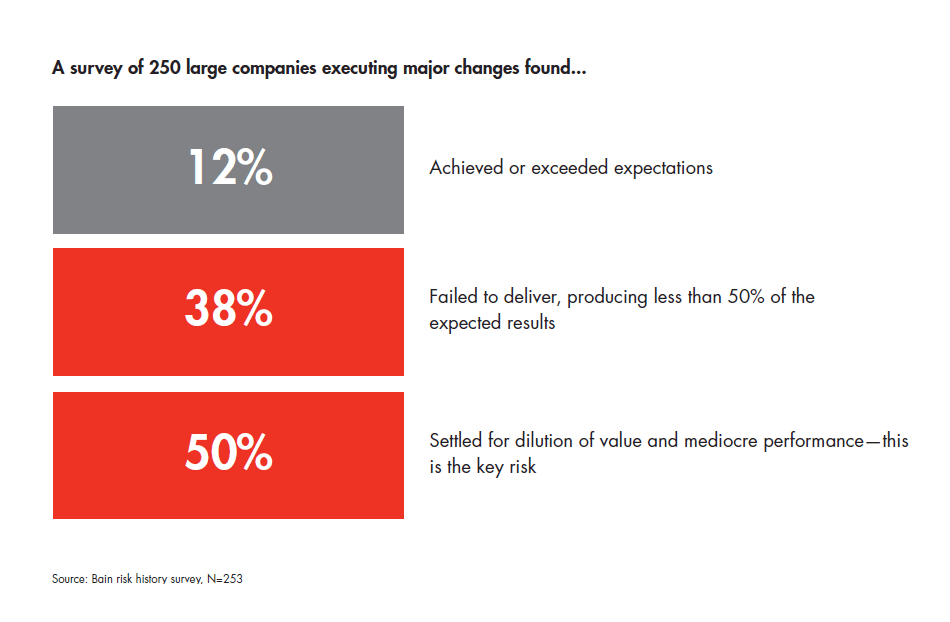
And yet they often have blind spots that can undermine a program, from the central vision to the relevant behaviors to the inherent risks. In successful programs, executives anticipate and overcome these blind spots. They do this by addressing the “what, who and how” of change:
- What do we want to achieve? (And why is this important?)
- Who will make change happen? (And who will support them?)
- How will we get there? (And what might get in the way?)
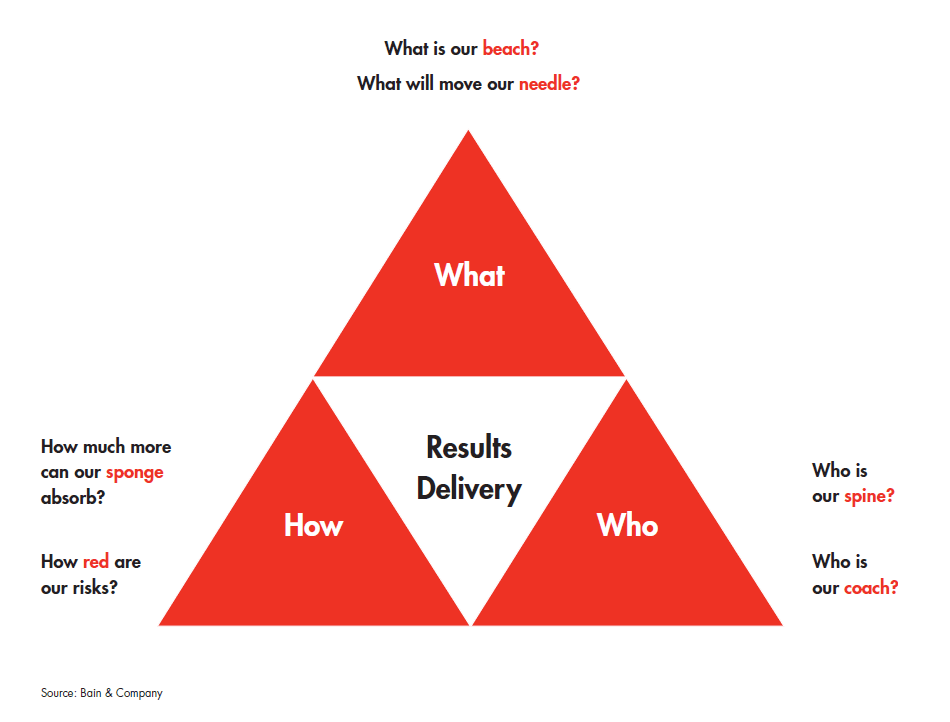
The what
Clear direction on changes to strategy, organization and processes are, of course, critical, but new programs most often fail in the implementation. And it’s the behavioral dimension that companies tend to neglect—especially the challenge of building a pragmatic plan to change the specific new behaviors required, both at leadership level and at the front line. To motivate large-scale organizational change, executives should ask, “What is our beach?” and “What will move our needle?”
What is our beach?
When planning a vacation, people get excited by imagining themselves on the beach or ski slope, not by reading the travel itinerary. Yet when embarking on a major program, executives often take more care in developing and communicating the details (risking “death by PowerPoint”) than the compelling vision. Effective change requires leaders who can inspire people and provide them with the internal compass to align their subsequent behaviors, decisions and actions. This vision often works more through metaphors and stories than facts, and it emphasizes the destination as well as the journey. It’s a narrative designed to capture hearts and minds. And the more that employees cocreate the vision, the more likely it is to succeed.
An inspiring vision played an essential role during the recent operating model redesign for a US-based consumer goods company. Activist investors had recently gained stature in the industry, and this firm realized it would need to ramp up international growth while, at the same time, taking out significant costs if it wanted to survive as an independent organization. One internal challenge was that, despite operating globally, the company made most decisions at its US headquarters.

Defining and communicating the case for change, then, had to actively involve senior leaders from all regions. They gathered over several sessions to flesh out the “beach” that would inspire employees to move beyond anxieties over layoffs and get excited by the chance to build a more innovative, growth-oriented business with greater local decision making. The firm trained leaders at every level and region to communicate a single global vision in their local context, so that the message was authentic. The head of the Asia-Pacific region, for instance, could genuinely discuss with employees how the project would yield savings globally that could be reinvested in that region.
As a result, every region actively supported the transformation, instead of paying lip service. One region that historically had gone its own way during other periods of change even invited the global HR team to help implement the program. A year after launch, senior managers would remind people of the initial vision in order to help them keep on track. And over the two years following launch, this initiative helped the company meet its annual growth plan for the first time in four years, with the stock rising to the top quartile of its sector’s performance.
What will move our needle?
Organizations don’t change, people do—through their behaviors. Of all the behaviors involved in a change effort, only a very few tend to produce the lion’s share of results. These identified behaviors must be concrete in nature— specific and practical—and should cover “moments of truth” relevant to the front line, such as how an agent handles a customer calling with a complex problem, or how a factory supervisor deals with a potentially dangerous incident. Blanket statements or top-down directives, such as “We will be more customer centric” or “Our leadership team will make decisions more quickly” might sound lofty, but each can be interpreted in many different ways, leading to inefficient or even conflicting behaviors across the organization. Executives should decide, in concrete terms, what frontline employees and management should do differently during those moments of truth.

Road shows, videos and training can activate change, but they don’t necessarily sustain change. Research overwhelmingly shows that reinforcement after the moment is critical for sustaining new behaviors, and that ideally the ratio of positive to negative reinforcement should be about 4 to 1. Reinforcement can include feedback from peers and supervisors, financial rewards and other forms of recognition.
AMP, a diversified financial services company based in Australia, is leaning on positive reinforcement to promote behaviors that will make the company more attentive and responsive to customers’ priorities— behaviors such as really listening to customer feedback and actively working with other departments to improve processes that touch customers. The transformation involves embedding the Net Promoter System®, which is a practical framework for earning greater customer loyalty.
Reinforcement takes different forms at different levels of AMP’s organization. As just one example, senior executives have part of their performance measured by how well they and their teams demonstrate customer-centric behaviors, such as regularly calling back customers who give negative feedback. On the front lines, some of the most effective reinforcement consists of small rewards plus recognition from peers and senior leaders for identifying and acting on insights. CEO Craig Meller spends a couple of days per quarter attending frontline team huddles that focus on customer issues, and he often calls out instances of customer-centric behavior by individuals in his regular companywide communications. Each type of reinforcement serves to elevate the topic and show how the right behaviors directly influence customer loyalty.
Alan Bird, an advisory partner with Bain’s Results Delivery practice, describes the risks of change and how CEOs can manage those risks by answering three basic questions.
The who
Who makes change happen? While some innovations come from people just doing their jobs, breakthrough ideas often need a dedicated effort from people freed from daily work pressures. But project teams overseeing the new program can become disconnected from the front line that carries out the change. It’s essential to identify who on the front line is most affected and how the company can support that group of people. The typical program office, set up to track progress, often fails to take on the important role of coaching line leaders so that they can support the core group on the front line. This raises two questions: “Who is our spine?” and “Who is our coach?”
Who is our spine?
Accountability for delivering results rests with line employees and their supervisors. So it’s critical to identify the people who will need to do business differently. And who has the greatest influence on these individuals grappling with behavior change? Their direct supervisor. Similarly, the person with the greatest influence over the behavior of that supervisor is his or her direct boss—and so on up the chain.
Change efforts depend on having this strong sponsorship spine. Once you recognize which people will be most affected by change, it’s crucial to identify who along the spine will be instrumental in sharing the case for change and motivating the right behaviors. Sponsors play five main roles:
- Set the context by reinforcing the need for change, articulating the “beach,” and then owning and committing to the desired outcomes.
- Engage with direct reports to help them, in turn, own and commit.
- Anticipate and mitigate risks, encouraging teams to speak up when they spot barriers to change.
- Establish a fair process that empowers people to contribute bold ideas.
- Communicate progress, solicit feedback and celebrate successes appropriately.
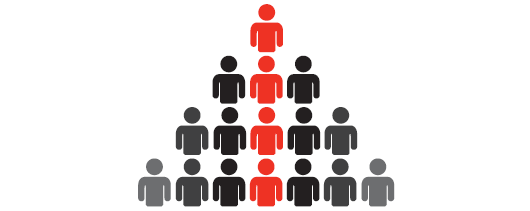
Gold Fields, a South African gold mining company, had to stabilize declining production as its mines neared the end of their lives by instilling higher-quality ways of working and effecting a marked improvement in safety. The challenge: inspiring 30,000 employees working in mines often three kilometers underground.
An initial approach relied on project teams to design, communicate and train on these new ways of working, but it failed to take hold. So Gold Fields turned to the sponsorship spine, with a monthly rhythm of training that cascaded through the mine hierarchy. This matched the pace of change with each mine’s capacity to adopt new ideas, and the ideas took hold because they were now promoted by experienced mine operatives who had credibility in the minds of their peers and subordinates. As mine teams could not readily be taken away from their working areas, these sessions mostly occurred at 6 a.m. on one Saturday morning per month.
As a result of its transformation, a much improved safety performance allowed Gold Fields to halt further declines in production, and its stock outpaced competitors during a challenging period for the gold industry as a whole.
Who is our coach?
A manager may be a great line leader yet struggle to deliver results from change programs. The good news is that the skills required for successful program delivery are relatively easy to learn. However, a spine is only as strong as its weakest link, and day-to-day business pressures may cause the spine to rapidly decay. This risk underscores the need for effective coaching of executives and frontline supervisors to perform their sponsor roles.
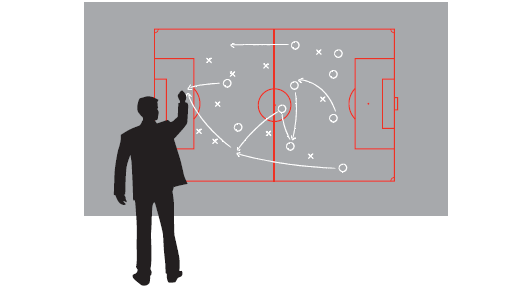
Coaching often works well through an enhanced program office—what we call a Results Delivery® office, or RDO. The RDO can serve as the custodian of the overall program design, ensuring that the design will realize the desired outcomes. It can assess risk, monitor progress against program goals and put in place the necessary interventions to ensure success. In order to make the results sustainable, the RDO should also provide coaching to the spine. This can even take the form of “tough love” measures, including giving feedback and advice to line leaders or recommending replacement of those who demonstrate a lack of capability or commitment. An RDO needs to ensure that frontline employees have full-on skill to actually change their behaviors.
Coaching has enhanced the ongoing transformation of Amgen, a US-based biotechnology firm. This transformation addresses a range of issues, from cycle time to cost to talent. Each initiative has been led by a vice president, who in turn is paired with a liaison to act as a coach through each of the initiative stage gates.
Coaching from the liaisons and the RDO have improved the quality of the output, increased the capability of the teams and raised the odds of the VP getting endorsement at each stage from the top-level steering committee, building confidence while avoiding rework and lost time. In addition, a number of liaisons and VPs elected to join a “master’s program” on competencies such as how to coach a team, develop a high-quality business case or perform an initiative risk assessment. These masters will serve as coaches for new initiatives that emerge over the coming years. Supported by strong coaching, Amgen’s transformation has allowed it to publicly commit to a 15-point improvement in operating margins by 2018 and helped double the stock price over the past three years.

The What, Who and How of Delivering Results
Most corporate change efforts fall short. To make change stick, ask these key questions.
The how
The pace and scale of a change program cannot exceed employees’ capacity to handle it along with all their other responsibilities. So take a breath, step back and ask, “How much more can our sponge absorb?” Then once a program starts, it’s important to maintain a clear sense of progress. Most organizations install tracking tools, using a green light for on track, yellow for at risk and red for stalled. Yet because people want to demonstrate progress, there’s an inherent bias toward showing green at all costs. To counter this impulse, executives should ask, “How red are our risks?”
How much more can our sponge absorb?
An organization’s capacity to manage change can easily be overwhelmed. What might seem from the top to be a logical sequence of initiatives can feel very different to someone on the front line being asked to engage with several initiatives at once while also carrying out business as usual.
Like a sponge soaking up water, individuals can absorb only so much and no more. Adding new initiatives without completing prior ones can exhaust or demoralize employees. The way to prevent this is to identify the people most affected by a change and chronicle what the company has asked them to do in recent months outside of their normal work. By mapping these activities, you can anticipate when people will get stretched too thin and then actively stop or delay lower-priority initiatives.
In 2012, South African oil, gas and chemicals company Sasol faced a continued rise in costs well above inflation despite several attempts to address the issue. So it decided to take a different approach and tackle the organizational complexity underlying its costs. Once it defined the actions to reduce complexity, Sasol mapped how those actions and other ongoing initiatives would affect different parts of the organization. This meant prioritizing initiatives and stopping those that were not essential, which in fact turned out to be the vast majority.
Executives found this process painful when their personal pet project was tagged, but they were convinced when they saw how the organization had become overloaded. Culling initiatives sent a powerful signal to everyone involved and helped make the transformation achievable; within 30 months, costs were running 7 percentage points below inflation, and cost savings were 67% ahead of target.
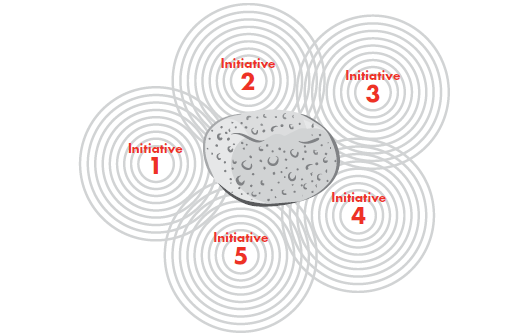
How red are our risks?
Change risks are predictable and therefore manageable. However, diagnosing the specific risks to a given program requires careful analysis. Executive teams have blind spots and biases—which also are predictable—so they may need help to surface hidden risks. And risks can change as an initiative unfolds. The ability to anticipate risks is essential to putting in place the necessary mitigating actions in a timely fashion.
There’s a natural desire to demonstrate progress and ignore the red-light warnings until a problem becomes severe—at which point, it may be too late. A risk-savvy organization takes a “red is good” stance, acknowledging individual risks that crop up so that they can deal with them early and completely. When leaders do this in a disciplined fashion, they can make an informed decision and address any blind spots that did not appear on the initial management agenda.
Consider the merger of two global pharmaceuticals companies, based in two countries an ocean apart. The team leading the integration launched a risk predictor survey covering 70% of the employee base, revealing several problems that senior management had overlooked. For example, many employees did not have a sense of what working in the combined company should look like and what it would mean for them personally. Worse, many felt they had no channel to provide feedback or raise concerns on how the new operation was proceeding. They felt the merger was done to them, not with them.
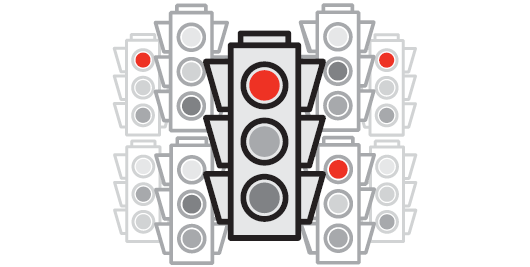
With this information, the executive board recognized the risk of losing crucial employee support, which could stall the integration and subsequent business success. So they took pains to communicate the target picture (the “beach”) for the new combined entity in terms relevant for individuals, including new global career options. Workshops involved employee teams in filling out the target picture and defining their own contribution. The firm also established a monthly risk monitoring and feedback process at the business unit level, and repeated its broader survey after six months. These mitigating steps helped to launch the integration with the majority of employees actively supporting it.
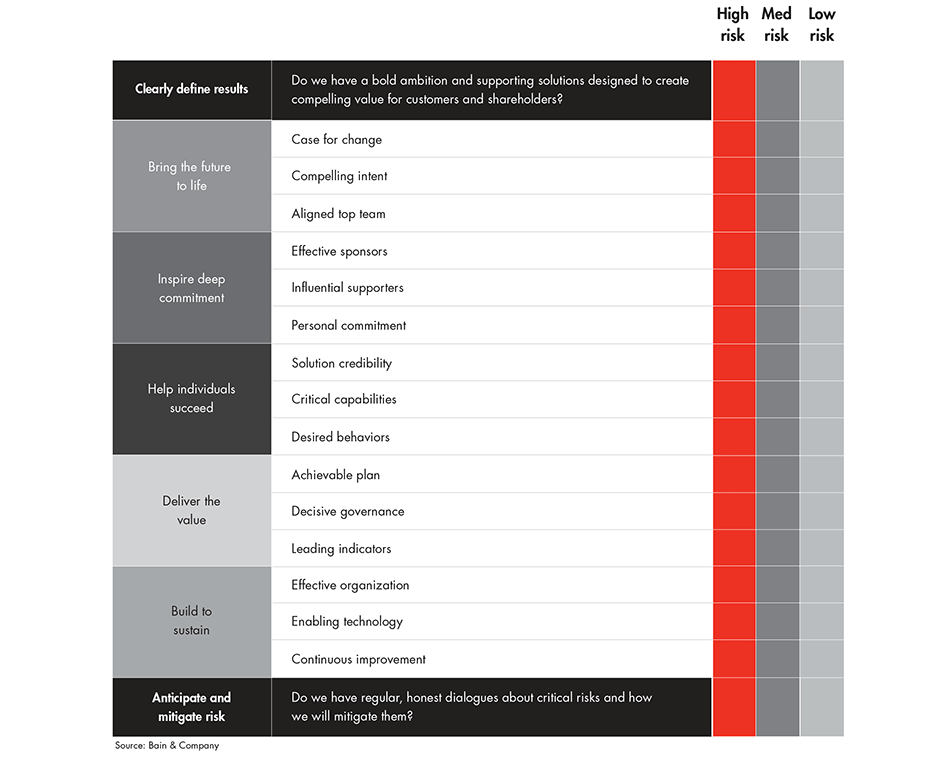
• • •
Executives who shape their efforts by understanding the what, who and how will not only increase their odds of success, but also develop the organizational muscles and agility to keep getting better at change.
Think about a program currently under way in your organization. Have you made a compelling case for change that inspires people to join the journey? Have you pinpointed the critical few behaviors and built the necessary reinforcements? Have you identified people who will be most affected by change and built the leadership spine to support them? Are you coaching your leaders to be effective change sponsors? Do your people have the capacity to focus on the initiative? Finally, have you identified the big implementation risks early on and put in place the necessary mitigating actions?
If you can answer these questions positively, then you are much more likely to be among the 12% of companies that actually attain the goals they set out to achieve.
Alan Bird founded Bain & Company’s Results Delivery® practice and is now an advisory partner. Torsten Lichtenau leads the practice in the UK. David Michels leads the practice in Europe, the Middle East and Africa.


